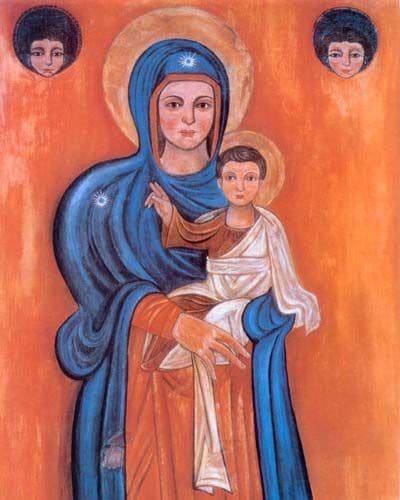
Eastern scholars and theologians suppose that both Eastern and Western Churches have shared the same approach to Marian devotion and the angelic salutation, divinely inspired and as uttered by Archangel Gabriel, since the Third Ecumenical Council at Ephesus in 431.
However, since the fourth century The Eastern tradition used the word rejoice instead of hail as we do now. And instead of full of grace, the original Greek translates to favored one.
It was not until the sixth century that the Angelic Salutation and Evangelical Salutation (the inspired greeting of St Elizabeth to the Virgin Mary), from Luke 1:28 and Luke 1:41-42 were combined and used in prayer.
In fact, this was a part of the Liturgies of St. James of Jerusalem, St. Mark of Alexandria, St. Basil the Great, and even in Jacobite prayer books! The best and oldest Angelic Salutation prayer formula was found in the Sacrament of Baptism book from 647 AD, by St. Severus, Patriarch of Alexandria, in the following way: “Rejoice, Mary, favoured one, for the Lord is with thee. Blessed art thou among women and blessed is the fruit of thy womb, Jesus Christ. Holy Mary, God-bearer, pray for us sinners. Amen.”
It is worth mentioning that this was the first known instance of a petition being added to the end of the Angelic Salutation. The standard traditional but not widely used form in the Eastern churches today, in English, is: “Rejoice, Theotokos Parthenos, Mary favored one, for the Lord is with thee. Blessed art thou among women and blessed is the fruit of thy womb, which has borne the Savior of our souls. Amen.”
Understanding the Rosary and The Mother of God in the eastern tradition
The word rosary comes from the Roman Latin Language “rosarium”, meaning a garden of roses.
In Our Eastern churches we have always associated Mary with rosarium/roses, way before the rosary came to us. This is especially because of the story of the Assumption or the “Dormition of the Mother of God” as we call it. Upon opening the tomb of the Blessed Mother, the disciples and apostles found it empty but for the strong smell of roses emanating from it.
So why the smell of roses? If we go back to the Old Testament to the book of Song of Solomon 2, a girl or bride the prospective Bride of The Lord is speaking, “I am a rose of Sharon, a lily of the valleys. Like a lily among thorns is my darling among the young women.” (Song of Solomon 2: 1-2)
We notice that the text does not say “the rose,” but “a rose”. This indicates humility.
In other words, she is saying she is a common, lowly flower of the lowlands, reminiscent of the words of Mary saying, “I am the Lord’s servant.”
Further and in Luke 1: 46-48, we read, “Mary said, for he has looked with favor on the lowliness of his servant.”
But the Lord God would lift the Blessed Mother up and will accomplish great things through her. Mary became the bride of the Holy Spirit, a Rose of Sharon as the scripture says.
Incidentally, Sharon is a plain area at the foot of the one and only Mount Carmel the mountain where the Virgin Mother is most venerated by both Eastern and Western Catholics.
We recall here how the visionaries of Our Lady of Fátima in 1917 – three shepherd children – reported that Our Lady of Mount Carmel is among the titles claimed by Mary in the apparitions. Our Lady identified herself to them as the Lady of the Rosary. A title appeared for the first time in the 12th century according to a Dominican tradition and the famous apparition to St Dominic.
This offers an even deeper understanding of the description from the litany to Mary, the “Mystical rose”. The bride of the Holy Spirit that was offered a Rosarium as a sign of Love from her Groom the Holy Spirit as a fulfillment of her prophecy when she said, “From now on all generations will call me blessed” (Luke 1:48).
The Rosary in the Maronite church
As Maronites the rosary came to us with the missionaries and became popular around the 19th century. Like all Catholics, we embedded the rosary in our daily lives and to our para liturgies, encouraging and promoting it at every instance.
When we pray the rosary we are participating in a universal Catholic traditional prayer but with a Maronite flavour, usually after praying the daily mystery we recite or sing the litany in a uniquely Eastern tune, followed by the Ya Oum Allah (O Mother of God) hymn and procession or “Ziyeh” with the Icon of our Lady, using a copy of the unique Antiochian Syriac Maronite Icon of Our Lady of Ilije form the 10th century.
“O Mary, Radiant Lily and Fragrant Rose, the aroma of your holiness fills the whole universe. Pray for us that we may be the sweet fragrance of Christ, reaching throughout the whole world. May our incense be for the preservation of the faith among the living, and for the salvation of the faithful departed that we may all inherit Eternal Life. Amen.” – Maronite Divine Liturgy to Our Lady
Father Eli Yammine is Assistant Priest at Saint Joseph’s Maronite Catholic Church in Croydon, NSW.
Related
